The near-ideal visual characteristics of OLED displays mean OLEDs will thrive as a mainstream display technology in coming years, while their compatibility with flexible and transparent materials is creating a new market for displays.
From the Apple watch to Samsung smartphones, LG televisions, virtual reality headsets and the first laptop screen, organic light-emitting diodes (OLEDs) are set to disrupt the display market. In addition, progress is underway as BMW and Audi release their first cars with OLED brake lights with more carmakers set to follow.
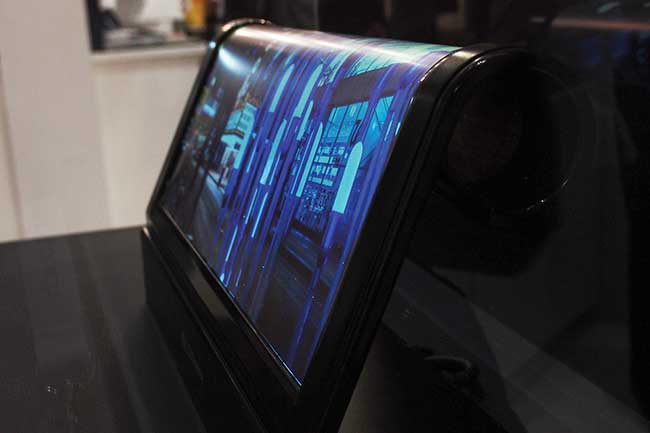
An 18-inch rolled OLED display made on a plastic substrate by LG Display. Courtesy of IDTechEx.
There’s big money associated with OLEDs: For manufacturers, production is expensive and the resulting item often carries with it a high price tag. But consumer demand for luxury products and significant price reductions mean that OLED technology is cropping up in an increasing array of high-end goods.
Substantial improvements to lifetime, energy efficiency and price mean that OLEDs are now enjoying a growing share of markets that had been solely the domain of LEDs and other light sources. With more manufacturers interested in investing, one of the remaining hurdles is spreading awareness of the merits of OLEDs to producers and consumers alike.
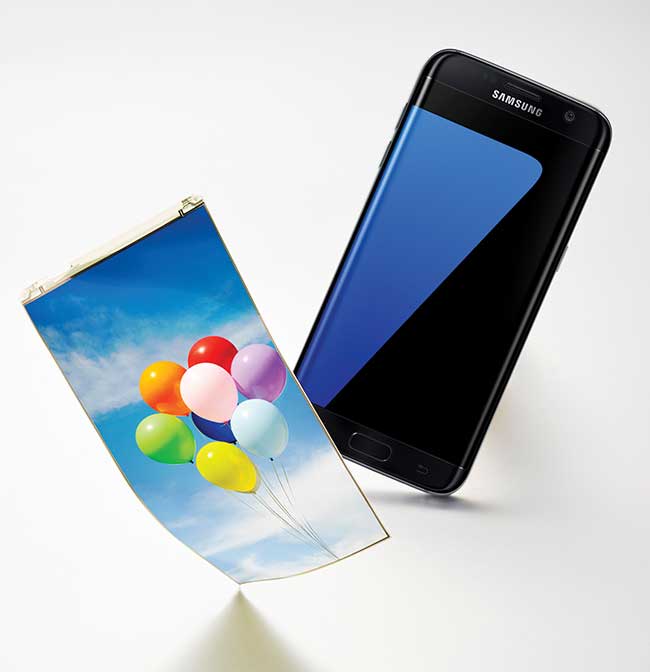
A flexible AMOLED along with a Galaxy S7, which incorporates a flexible display for its “edge-type display.” Courtesy of Samsung Display.
Mobile displays and flexible substrates
Apple has made a number of initiatives in mobile display technology, but rather than OLED screens, the company introduced very high resolution with its “Retina” concept in its iPhones in collaboration with display companies such as LG Display. Speculation is rife as to whether iPhones will eventually use OLEDs, with many believing it’s a case of “when,” not “if” — particularly as we now see OLEDs on the Apple watch.
“As a planar, rigid display, both AMOLED [active matrix OLED] and IPS [in-plane switching]-based LCD displays have a comparable performance and characteristics, at least for ordinary users. This was particularly the case until recent years,” said Seunghyup Yoo, a professor from the Korea Advanced Institute of Science and Technology (KAIST) based in South Korea. “Times are changing, however, as AMOLED displays are becoming more cost-effective and their characteristics such as fast response time are making it easier to embrace emerging applications like virtual reality.”
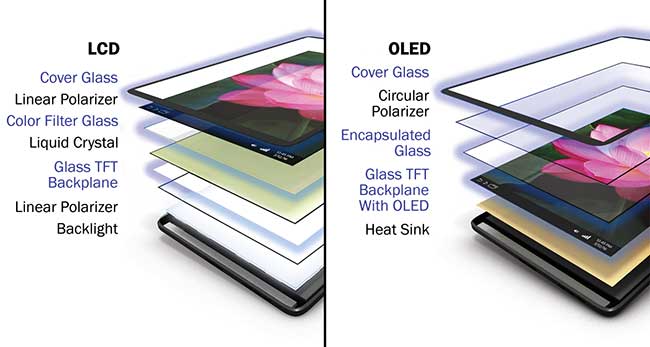
Both OLED and LCD display panels serve important roles depending on the attributes a device maker wants to provide to consumers. Key differences lie in how light is emitted through each panel to create each pixel of light in a display. While LCDs use a backlight to project light through a color filter, OLEDs use organic, self-emitting diodes to create images. Courtesy of Corning Inc.
What’s more, when prepared on a plastic substrate, AMOLEDs can provide a design freedom such as a bent-edge display as well as being lightweight, leading eventually to flexible or bendable displays.
Michael Kunigonis, business director of high-performance displays at Corning Inc., with headquarters in Corning, N.Y., points out that the challenge with using plastic substrates is they are not dimensionally stable enough to endure the high-temperature manufacturing process required to build these panels.
A display-quality carrier glass like Corning Lotus NXT Glass that features dimensional stability enables efficient manufacturing of flexible OLED panels. These flexible OLED display panels can be bent and conformed to create curved displays.
“A dimensionally stable carrier glass — with low total pitch variation and low total thickness variation — enables a well-aligned TFT [thin-film transistor] array and an even deposition of OLED material, overall contributing to a well-constructed panel that helps panel makers avoid yield loss,” said Kunigonis. “A carrier glass should also have a high UV transmission, allowing a large amount of light through the carrier at an even distribution, enabling efficient laser lift-off, a vital step in the flexible OLED panel-making process.”
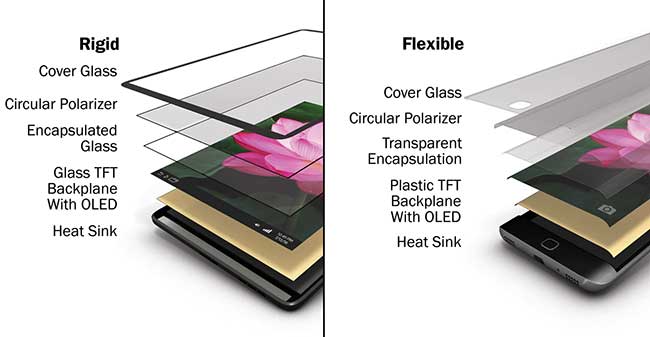
An OLED display panel can be made either rigid or flexible, depending on the desired use. A flexible OLED display generally uses a plastic substrate and requires a display-quality carrier glass to take it through a demanding manufacturing process. The carrier glass is removed once the panel is complete. Courtesy of Corning Inc.
A flexible OLED panel begins with a glass substrate, used as a carrier glass. A plastic layer is deposited and cured onto the carrier. At the end of the panel-making process, a UV laser shines through the display-glass carrier to debond it from the flexible OLED panel. The panel can then be conformed to create unique device designs. So far, Samsung has been the main manufacturer of mobile OLED displays. OLED displays on plastics, used in Samsung’s Galaxy Gear series and in its edge-bent displays in its Galaxy Note Edge series, are examples of successful commercialization of AMOLEDs, but carrying forward this technology to large-size TVs and plastic substrates is considered the next level of challenges.
“For OLED displays, manufacturers are still working on ways to make them bigger and cheaper. This year, we have the first generation of laptops with OLED screens, but they cost a premium,” said Guillaume Chansin, Ph.D., senior technology analyst and lead author of the OLEDs Displays Forecast 2016-2026 at IDTechEx (www.idtechex.com), a market analysis and consulting firm with headquarters in Cambridge, England. “Investing in a new technology is always risky. LG has been very bold and now they are the only supplier of large OLED screens.
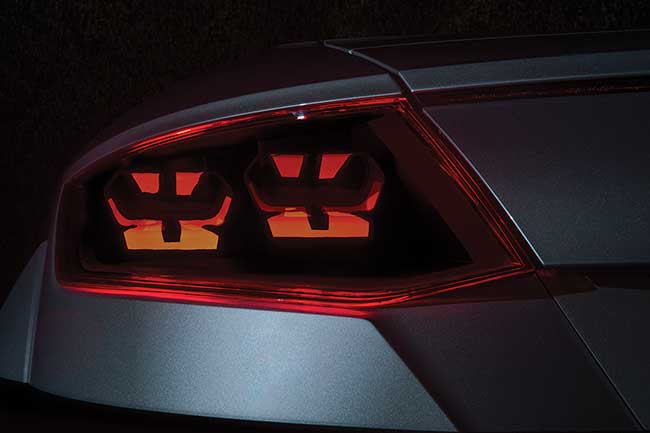
A rear light module from a single flexible OLED produced as part of the R2D2 project in cooperation
with Audi, Osram and Hella. Two such modules are installed in a complete rear light unit. Courtesy of Osram.
Consumers seem to be very enthusiastic about OLED, so I think other manufacturers will follow.”
LG Displays came up with a subpixel structure in which white OLEDs (WOLEDs) are combined with RGB color filters. WOLEDs are by themselves individual pixels and thus can be addressed independently — the image is in black and white, and color is rendered using color filters on each pixel.
This means that there must be a compromise in efficiency since a significant portion of white light should be filtered out to define a specific primary color. Even so, the simplified manufacturing process for RGB pixel patterning has led to successful commercialization of OLED TVs that are 55 inches or larger in diagonal.
“LG was the first TV manufacturer to commit and invest in OLED technology a few years ago and we are now reaping the rewards with sales of LG OLED TVs continuing to increase,” said Robert Taylor, product manager at LG Electronics UK. “Other TV manufacturers have been more cautious, likely to be down to the significant investment in the production facilities needed to create OLED panels, ultimately resulting in a more expensive consumer product.”
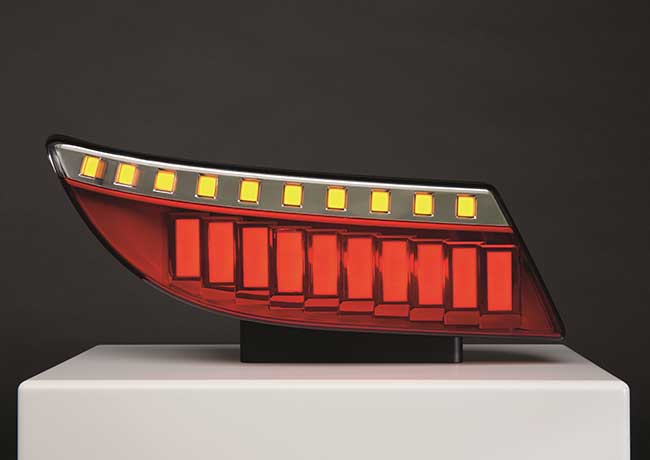
Osram’s taillight is able to play special light sequences thanks to segmentation. Courtesy of Osram.
As LG points out, OLED technology is expensive to produce and it’s a technology that not all consumers are familiar with.
“While demand for OLED TVs is increasing there is still some work to do in educating consumers on the benefits of OLED,” Taylor said. “However, with LG making more OLED TVs in its range than ever before this year, the price points for LG’s OLED TVs have become more varied, which is encouraging for other manufacturers to see.”
Architectural lighting and automotive opportunities
Lighting devices are generally much easier to fabricate than display devices because they do not involve integrated thin-film transistors and high-resolution patterning. Nevertheless, they typically require higher brightness levels than display applications, which makes practical deployment of OLED lighting much more challenging as efficiency and lifetime can degrade rather significantly when brightness level increases.
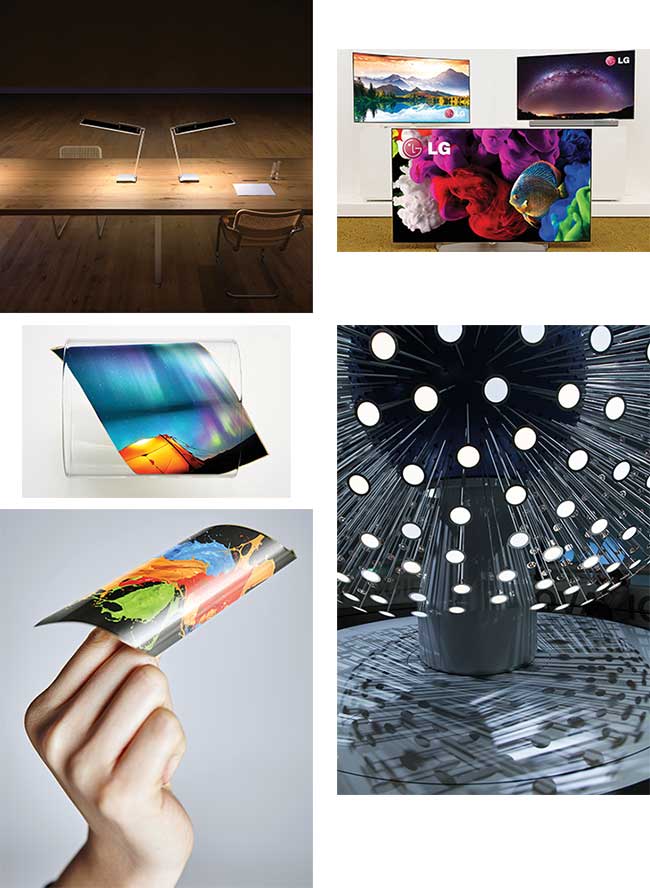
With significant price reduction, there is increased interest in more traditional markets such as task lighting. The OMLED from EMDE Design GmbH is a platform product that used between one and five Lumiblade panels from OLEDWorks LLC in a desk lamp configuration (top left). LG boldly stepped out as the first and only supplier of large OLED televisions in its 4K OLED TV products (top right). Flexible active matrix OLED (AMOLED) displays in operation (middle and lower left). This OLED flower is part of Osram’s OLYMP project, which aims to make OLEDs attractive for the mass-market general lighting sector (above). Courtesy of EMDE, Samsung Display, LG Electronics and Osram.
While OLEDs have not yet significantly entered the residential or office lighting market due to performance and cost, a healthy market does exist in targeted segments where “design” matters and where lighting solutions can tolerate a price premium — such as in architectural lighting.
“Architectural lighting is indeed one of the opportunities for OLED lighting. Technology, however, is not driven by power consumption but by design. Growth in general has been delayed due to the cost position,” said Nadine Schian, head of communications for Specialty Lighting at OSRAM GmbH, Munich. “Cost reduction can be achieved by, for example, upscaling and acceleration of the production. However, huge investments are needed for this.”
With cost and performance parameters improving slowly, more manufacturers view OLEDs as a way to complement and differentiate with respect to LEDs.
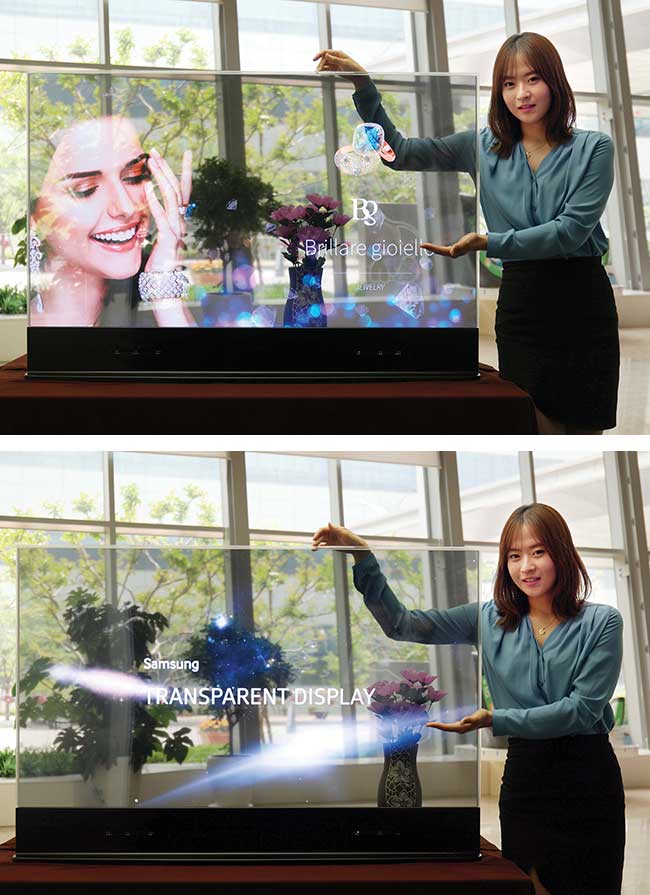
A 55-in. transparent AMOLED display. Courtesy of Samsung Display.
“The technology and integration requirements of LEDs were at first very demanding for manufacturers and they did not have the energy or time for OLEDs — that is no longer true,” said Giana Phelan, director of business development at light engine and panel manufacturer OLEDWorks LLC, located in Rochester, N.Y. “We see the growth related to our product performance; our panels are substantially the brightest available and this enables affordable functional light, with superb light quality, in elegant OLED fixture designs.”
The automotive industry is a promising new market, with OLEDs giving car makers another technology that can reinforce their brand through design. One aim is to replace some of the lights with OLEDs and another is to improve the driving experience with beautiful displays.
“If one looks at the cars released these days, there are more and more IT devices being added and their tachometers are now displays, rather than needles over a printed scale,” said KAIST’s Yoo. “Lightweight, free-form design features of OLED displays on plastics can become very promising for such futuristic automobiles, and some high-end automakers are considering using OLED technologies for the tail lamp of their cars.”
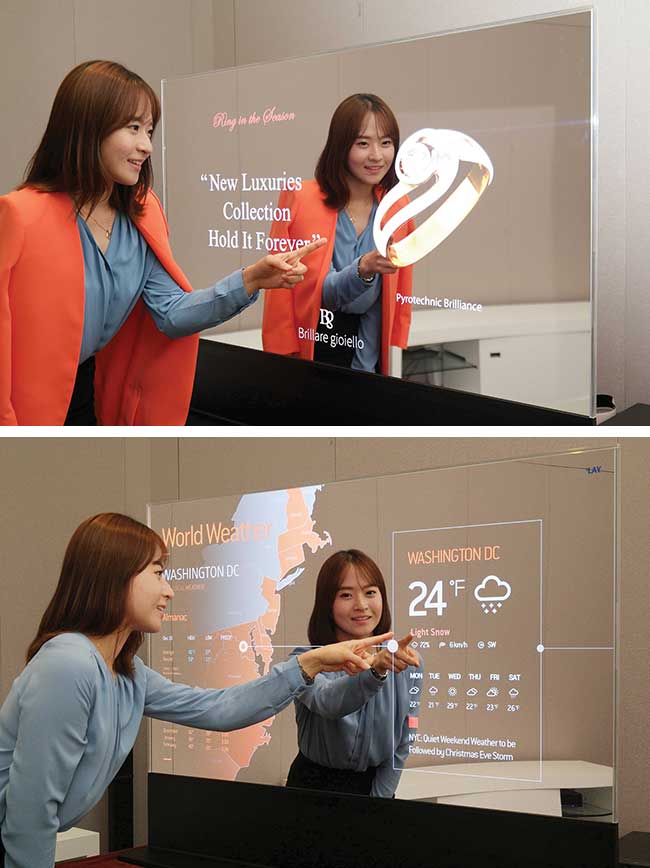
A mirror display based on AMOLED technology. Courtesy of Samsung Display.
In fact, BMW’s M4 GTS and Audi’s soon-to-be-released TT RS coupe have adopted Osram’s OLED lighting technology in their rear lights.
“We improved the OLED performance, such as the encapsulation, heavily, in order to meet strict automotive requirements,” Schian said. “We see a huge interest from automotive industry in this technology and expect a fast penetration, especially in the more luxury vehicles.”
BMW has opted for a fanlike design, which takes advantage of the flatness of OLEDs and acts as a design highlight, particularly when viewed slightly from the side. With a total of 15 OLEDs per taillight and a brightness of 1200 cd/m2, a 3D effect can be created by segmentation. The possibility of controlling individual light modules separately opens up even more design options such as dynamic functionality.
In a short space of time OLED technology has advanced rapidly, offering consumers a wide range of options from curved and flat screen designs to elegant, on-brand motifs. The innovations are a result of consumer demand for the latest technology that takes advantage of their thinness and flexibility. OLED devices will continue to improve, and as consumers become increasingly aware of the technology, there is no doubt that adoption will be on the up.